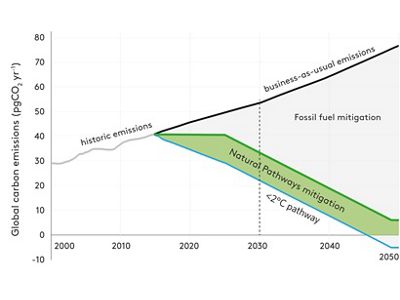How Nature Can Get Us 37 Percent of the Way to the Paris Climate Target
By Bronson Griscom, Director of Forest Carbon Science
The last two years have seen significant global advancement on climate action, with hundreds of global businesses and national and sub-national leaders building on the momentum of the Paris Agreement to initiate new climate pledges, initiatives and funding programs. But there remains a gap between promised action and realized climate progress, and many solutions available to us now remain underutilized—especially in the land sector, which currently accounts for nearly a quarter of greenhouse gas emissions.
In fact, new research shows that stewardship of the land can play a significant role in keeping global temperature increases under 2 degrees Celsius. The Nature Conservancy partnered with the Doris Duke Charitable Foundation to bring together more than two-dozen expert scientists specializing in conservation, climate modeling, and economists from a variety of global institutions to explore this issue. They found that nature’s ability to mitigate climate change is about 30 percent higher than previously projected.

These results are described in “Natural climate solutions,” published in Proceedings of the National Academies of the Sciences. The paper shows that with concerted global action between now and 2030, better land stewardship offers 37 percent of the solution for keeping global temperatures to 2 degrees Celsius or below—the same as if the world today put a complete stop on the burning of oil. In addition, the paper’s economic analyses show that natural climate solutions—the proven ways of storing and reducing carbon emissions in forests, grasslands and wetlands—can provide low-cost opportunities and are often significantly more cost effective when compared to technological solutions.
The world risks losing these opportunities, however, if we continue with a business-as-usual approach. Increased emissions entering the atmosphere coupled with continued environmental degradation will lessen the impact that nature can have. If natural climate solutions are mobilized over the next 10 to 15 years and coupled with reduction in fossil fuel emissions, they could provide 37 percent of the needed mitigation for global climate targets. But if action is delayed until after 2030, that number drops to 33 percent, and drops again to only 22 percent after 2050.

Right now, variations of land-based climate solutions appear in more than 75 percent of individual country commitments to the Paris Agreement, yet renewable energy, energy efficiency and clean transport together receive nearly 30 times the amount of public mitigation investment that land-based solutions receive. Of the funding that is set aside for natural climate solutions, the vast majority tends to focus on tropical forest protection in developing countries. But this study shows that a variety of natural climate solutions—including those in grassland, agricultural and wetland ecosystems—are relevant across the globe and can have a large impact on almost any country’s emissions. Furthermore, these solutions bring added social and environmental benefits, such as cleaner air and water, sustainable food production and increased habitat.
Climate change is the largest and most complex environmental crisis we have ever seen. Mobilizing natural climate solutions doesn’t mean that we should cut back on the research and development of renewables, electric cars, energy efficiency methods. Nor is action on natural climate solutions a substitute for ceasing to burn fossil fuels. Rather, in addition to low-carbon measures, they are the only realistic way to achieve sufficient emissions reductions to defeat climate change.
While looking forward, we can’t lose sight of one of the most important solutions—just under our feet.
Learn more about natural climate solutions: explore TNC features and case studies, and access the full report.
Originally Posted on Ecosystem Marketplace
October 19, 2017
View Original

